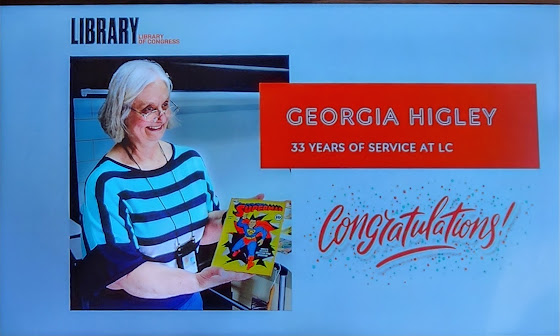I don't know if anyone actually ever called her "America's comic book librarian," but someone should have.
On October 31, 2023, Georgia Higley retired from the Library of Congress (LOC) where she had worked for 33 years upon joining the staff as a library intern in 1990. Georgia had been in charge of the Newspapers and Current Periodicals division and had overseen the rebuilding, strengthening, and spotlighting of one of the largest comic book collections in the world and possibly the largest in America. The website for the collection calls it, "The largest publicly available comic book collection in the world is comprised of over 165,000 original print issues and 12,000 different titles that span 1934-present."
The following bullet points about her career were initially pulled from the LOC's internal newsletter The Gazette (January 30, 2004) and updated by one of her colleagues:
- Began her career at the Library of Congress on September 4, 1990.
- Served in varying capacities: intern, reference librarian, automated reference service specialist, acting head of Reference Section, co-founder of the LOC Reference Forum, trustee for the LOC Professional Association Continuing Education Fund, section head of Newspaper and finally newly reorganized Physical Collections Services Section
- Headed the Newspaper Section from 2004 to 2020.
- In 2020 appointed head of the Physical Collections Services Section – a combined section of newspapers, government documents and current periodicals, responsible for acquiring, preserving and serving physical collections of the division.
- Significant force behind the expansion and preservation of the comic book collection in the early 2000s through today.

While Georgia was running the section that collected comics, in 2011 the Library and the Small Press Expo (SPX) began to work together to ensure the preservation of America's alternative and mini comics through a cooperative program that saw LOC librarians fanning out throughout the SPX exhibit floor and asking cartoonists to donate copies of their works. Those works were then added to a Small Press Expo collection (actually two - one of comic books, and one of original art, prints, and ephemera) at the Library. As of this writing 3,345 comics have been cataloged. The project is the work of scores of people, but Georgia has been one of the mainstays of it.
This article has been posted simultaneously to the ComicsDC and International Journal of Comic Art blogs.





















